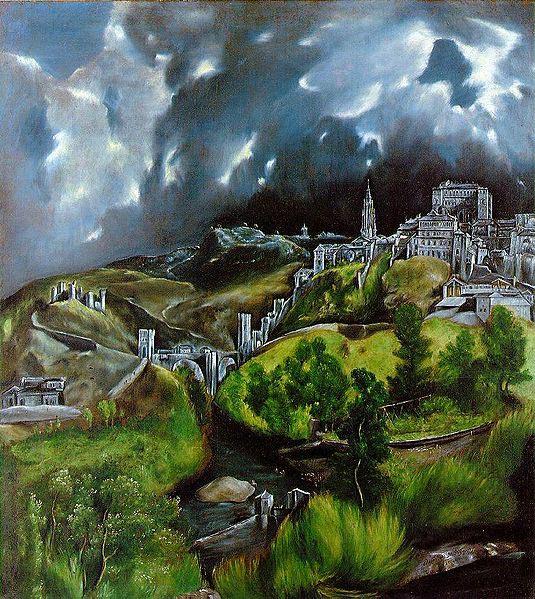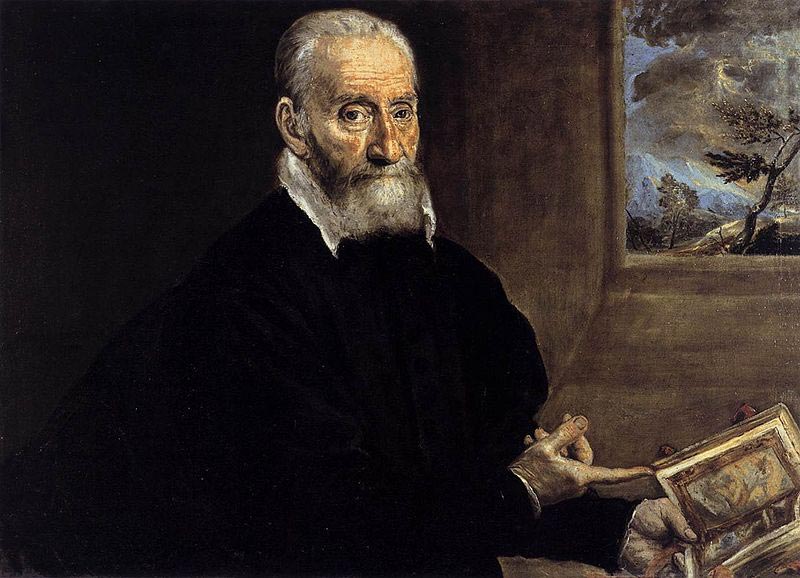| El Greco | |
|---|---|
 |
|
| Born | Doménikos Theotokópoulos 1541 Kingdom of Candia |
| Died | Apr. 7, 1614 (at age 72–73) Toledo, Crown of Castile |
| Nationality | Greek |
| Movement | Mannerism |
| Field | Painting, sculpture and architecture |
| Famous Paintings by El Greco | |
| The Disrobing of Christ, 1577–1579 | |
| Opening of the Fifth Seal, 1608-1614 | |
| Dormition of the Virgin, 1565-1566 | |
| The Burial of the Count of Orgaz, 1586 | |
| View of Toledo, 1596-1600 | |
| The Adoration of the Shepherds, 1612–14 | |
| Christ Healing the Blind, c. 1570 | |
| The Entombment of Christ, c.1570 | |
| St. Martin and the Beggar, 1597-1599 | |
| Complete Works |
During the Spanish Renaissance, one man named El Greco served as the primary influence of painters to come, with his contributions in the fields of Cubism and Expressionism. For thousands of years, not even one artist came close to his style of painting and sculpture, and even up to this day, most people have consulted for his techniques that combine those of Western style painting and Byzantine culture. This world-renowned artist faced many trials and hardships, especially during his start of his artistic career and until several years after his death, but it was not too long after that many artists started appreciating his works of art.
El Greco was born as Doménikos Theotokópoulos in 1541 to his father Geórgios Theotokópoulos, a tax collector and merchant in his time, and his Greek mother, who has remained somewhat of a mystery even today. The family belonged to the middle class and lived in a village on Chania, Crete, but the uprising against the Venetians some time between 1526 and 1528 led them to move away to Candia afterwards. Even in his childhood, young El Greco showed huge interest and talent in the field of art, and became enthusiastic in taking up training as an icon painter and studying the cultures of Ancient Greece and Latin traditions and culture in a Cretan school, which was the main source of post-Byzantine style of painting that time. It is important to note that Candia was actually the famous center of art that time where the combination of Western and Eastern cultures thrived, and this was also the place where numerous painters gathered to form a painters’ guild.
In June of 1566, after three years, he officially signed his name as “Master Menégos Theotokópoulos, painter” as a witness to a contract. After some time, he decided to continue his career in Venice, where a friend he met there named Croatian Giulio Clovio even recognized him as a “rare talent in painting.” During his time there, instead of staying with the usual trends, El Greco sought to invent uncommon interpretations to topics about religion, using a style that highlights elongated figures, multi-figured compositions, vibrant lighting, and chromatic framework. In 1570, he eventually went to Rome in order to hone his skills further.
 It was during his stay in Rome that he discovered a new technique while he was sitting in a dark room, wherein he observed that the darkness disturbed his “inner light” and that it was more interesting than the light of the day itself. This new thought sparked new interest, and this was evident in his works that were full with strange Mannerism techniques like twisted and intense gestures and violent vanishing points. During his stay, he praised some artists, but he made harsh criticisms on some like Michelangelo, which he referred to as a “good man who did not know how to paint.” Due to his obnoxious nature, he has gained attention from other artists as well, who did not like his attitude.
It was during his stay in Rome that he discovered a new technique while he was sitting in a dark room, wherein he observed that the darkness disturbed his “inner light” and that it was more interesting than the light of the day itself. This new thought sparked new interest, and this was evident in his works that were full with strange Mannerism techniques like twisted and intense gestures and violent vanishing points. During his stay, he praised some artists, but he made harsh criticisms on some like Michelangelo, which he referred to as a “good man who did not know how to paint.” Due to his obnoxious nature, he has gained attention from other artists as well, who did not like his attitude.
In 1577, he soon went to Madrid and then to Toledo to create most of his mature work. Unlike his stay in Rome where he was disgustingly criticized by most art critics, he regained a huge reputation in Toledo where he contributed world-renowned paintings like the El Espolio and nine paintings to complete The Trinity and The Assumption of the Virgin in the church of Santo Domingo el Antiguo. His aim that time was to gain the interest of King Philip II, but unfortunately he was not happy with his works due to a few reasons which included being uncomfortable with the inclusion of living bodies in a religious artwork or the violation of the Counter-Reformation rule wherein the content was more prominent than the style. Because of the King’s disapproval, El Greco was forced to remain in Toledo to form contracts and commissions and accept numerous works to earn a living.
 His works of art remained as the sole inspiration of most painters including Pablo Picasso. All his paintings came from his beliefs about the dominance of imagination over the subjective character of creation, the rules of measure and proportion, the elegance of elongated figures, the emphasis on the “inner light,” the importance of grace in art, and the fact that color was the most important element of painting, and even emphasized the importance of retouching. His paintings gave a more profound feel of dramatization instead of description, and his powerful religious emotions are well portrayed in paintings such as The Disrobing of Christ, which was considered as one of his most important creations. Other than his evident works, he was an excellent portraitist, architect and sculptor.
His works of art remained as the sole inspiration of most painters including Pablo Picasso. All his paintings came from his beliefs about the dominance of imagination over the subjective character of creation, the rules of measure and proportion, the elegance of elongated figures, the emphasis on the “inner light,” the importance of grace in art, and the fact that color was the most important element of painting, and even emphasized the importance of retouching. His paintings gave a more profound feel of dramatization instead of description, and his powerful religious emotions are well portrayed in paintings such as The Disrobing of Christ, which was considered as one of his most important creations. Other than his evident works, he was an excellent portraitist, architect and sculptor.
On April 1614, he died after contracting a fatal disease. On March 31, his will instructed his son to write his will. However, his posthumous legacy remained as the sole driving purpose for more artists to come.